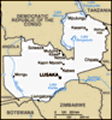Advertisement
Published: August 6th 2012
Although we've done lots of safaris, this was our first night game drive. It's a whole different experience.
The South Luangwa NP is reputed to have the best guides anywhere in Zambia, and it was certainly the case with our guide, Riva. He has been doing this for over 13 years, and knows the park and the animals very well. The driver from our lodge tagged along to help with the spot light. Yes, spot lights are permitted, but we must exit the park by 21:00, so animals get a respite from human activity.
The park is known for the large herds of buffalo that congregate in the dry season, and is the best for spotting leapoards.
The drive started at 16:00 and we saw the usual suspects - Baboons, Hippos, Impala, Water Buck, and also Puku - an antelope related to the Water Buck - Elephants, and a few large herds of Buffalo.
Then the modern jungle telegraph came alive. It comes in two parts nowadays. The first part is the cell phone. Yes, cell phones work even in these remote areas. And the second part is the drvers speaking to each other. No need to
beat drums here. The cell phone informed us that a leapard had been sighted up in a tree, so off we went. The light was still good to clearly see the leopard. It was a big male.
When too many safari trucks surrounded his tree, he just got up and left. We were the last group to get a good view of the leopard. The drove of safari trucks that followed only got to see a fleeting glimpse of the leopard in the bush.
It was getting dark, so out came the spot light. It was very bright.
Antelope look different in the dark. At first, all you can see are the eyes. A whole sea of glistening eyes. Then the spot light picks up individual animals. Since other trucks also have spot lights, there's some interesting lighting effects. We saw a hippo out of the water, eating the fruit of the sausage tree - one of it's favourites. We saw many antelope and then a lone hyena. Turns out most hyena are loners in South Luangwa NP. There was a herd of Impala very close, but the hyena made no attempt to catch them. It must
be experienced enough to realize that it can't keep up a chase with antelope.
Then we spotted a Leopard out in the open. Soon, there were other safari trucks in the vicinity, all spot lighting the leopard. The leopard was sniffing the air. Our guide said, there must be a kill up a tree, because the leopard was approaching the huddle of trucks while sniffing the air. So, he pointed the spot light onto the nearest tree and sure enough, we saw an Impala tail high up in the tree. There was another leopard up the tree with the kill.
Wow! Two leopards near the same tree. Leopards are very territorial, so this was a rare sight indeeed. The one on the ground was a female, and judgng by the size, the one in the tree was a male. The female approached the tree, and soon grabbed onto a piece of flesh that fell down.
But, it ran away. That's when we noticed a hyena was chasing it for the scrap meat it had. The female effortlessly climbed another nearby tree. The hyena parked itself under the first tree, and we could hear it cracking bones, as
it got at the marrow. We were surprised how big the hyena was compared to the female leopard.
The male up the tree, finished the last of the carcass, and came down into the grass near our truck to clean itself up. The hyena was busy cracking bones, and was not interested in tangling with the larger male leopard. It was a perfect end to the night drive.
On the way home, we also saw Hare, Ganet, and a Civet.
On returning to our lodge, we weren't even that disspointed when we were told that we couldn't go on a game walk in the morning because there was no "scout" available - a scout assigned by the NP is required for all game walks, as they are authorized to carry a gun, and use it to scare aware animals if needed.
Since early morning is the best tme for a game walk, we'll try for a game walk on the following morning, before we head to Lilongwe in Malawi.
Advertisement
Tot: 0.142s; Tpl: 0.025s; cc: 8; qc: 53; dbt: 0.0802s; 1; m:domysql w:travelblog (10.17.0.13); sld: 1;
; mem: 1.2mb










